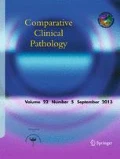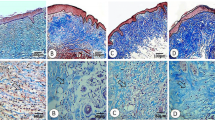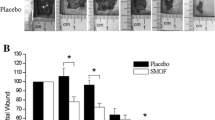Abstract
This study was conducted to compare the traditional prescriptions of flaxseed and Pistacia atlantica oil in wound healing in rabbit. Eighty white New Zealand rabbits randomly allocated to five experimental groups (n = 16). Two full-thickness skin excisional wounds were created on the thoracolumbar region on each side of the dorsal midline in each rabbit. Group 1 was considered as control. Group 2 rabbits received nitrofurazone ointment (0.2 %, w/w). Group 3 animals were treated with P. atlantica hull (2 %) ointment. In group 4, rabbits received flaxseed ointment (2 %), and group 5 was treated with combination of flaxseed (2 %) + P. atlantica hull (2 %) ointment. Animals were anesthetized, and the skin of specimens were taken in 3, 7, 14, and 21 days postoperative. Tissue samples were dissected out and quantity of cellular infiltration (polymorphonuclear and mononuclear cells, new vessels, and fibroblast formation) and angiogenesis were estimated. Also, the wound-healing area (mm2) was evaluated in 4, 8, 12, 16, and 20 days postoperative. According to the result, flaxseed and pistachio oil ointment significantly decreased polymorphonuclear and mononuclear cell distribution on day 3 postoperative (P < 0.05). Also, co-administration of flaxseed + pistachio oil significantly improved new vessel formation compared to other groups (P < 0.05). Furthermore, flaxseed and pistachio improved subsequent fibroblast distribution in injured rabbit (P < 0.05). Moreover, rabbits, which received the combination of flaxseed + pistachio, had better wound healing compared to control group (P < 0.05). Our data suggested that co-administration of the pistachio and flaxseed promoted the healing process by shortening inflammation phase, elevating cellularity, and promoting collagen synthesis.

Similar content being viewed by others
References
Abad ANA, Nouri MHK, Tavakkoli F (2011) Effect of salvia officinalis hydroalcoholic extract on vincristine-induced neuropathy in mice. Chinese J Natur Med 9(5):354–358
Asadpour R, Azari M, Hejazi M, Tayefi H, Zaboli N (2013) Protective effects of garlic aqueous extract (Allium sativum), vitamin E, and N-acetylcysteine on reproductive quality of male rats exposed to lead. Vet Res Forum 4(4):251–257
Boelsma E, Hendriks HFJ, Roza L (2001) Nutritional skin care: health effects of micronutrients and fatty acids. Am J Clin Nutr 73:853–864
Chen W, Liou S, Tzeng T, Lee S, Liu I (2012) Wound repair and anti-inflammatory potential of Lonicera japonica in excision wound-induced rats. Compl Alter Med 12(226):2–9
Datta HS, Mitra SK, Patwardhan B (2011) Wound healing activity of topical application forms based on ayurveda. Evid Based Complement Alternat Med. doi:10.1093/ecam/nep015
De Souza Franco E, De Aquino CMF, De Medeiros PL, Evencio LB, Da SilvaG’oes AJ, De Souza M, Bernadete M (2012) Effect of a semisolid formulation of Linum usitatissimum L. (Linseed) oil on the repair of skin wounds. Evidence-Based Complement Altern Med. doi:10.1155/2012/270752
Derakhshanfar A, Oloumi MM, Mirzaie M (2010) Study on the effect of Peganum harmala extract on experimental skin wound healing in rat: pathological and biomechanical findings. Comp Clin Pathol 19:169–172
Estevão LRM, de Souza MF, Baratella-Evêncio L, Simões RS, de Barros MEG, Arantes RME, Rachid MA, Evêncio-Neto J (2013) Effects of aroeira (Schinus terebinthifoliu Raddi) oil on cutaneous wound healing in rats. Acta Cir Bras 28(3):202–209
Farahpour MR, Habibi M (2012) Evaluation of the wound healing activity of an ethanolic extract of Ceylon cinnamon in mice. Vet Med 57(1):53–57
Farahpour MR, Taghikhani H, Habibi M, Zandieh MA (2011) Wound healing activity of flaxseed Linum usitatissimum L. in rats. Afr J Pharm Pharmacol 5(21):2386–2389
Francis AA (2012). The effects of dietary flaxseed on atherosclerotic plaque regression. Master of Science Thesis in Physiology. University of Manitoba
Giner-Larza EM, Ma’n˜ez S, Recio MC, Giner RM, Prieto JM, Cerda’-Nicol’as M, R’ıos JL (2001) Oleanonic acid, a 3-oxotriterpene from Pistacia, inhibits leukotriene synthesis and has anti-inflammatory activity. Eur J Pharmacol 428:137–143
Koch AE, Polverini PJ, Kunkel SL, Harlow LA, DiPietro LA, Elner VM, Elner SG, Strieter RM (1992) Interleukin-8 as a macrophage-derived mediator of angiogenesis. Science 258:1789–1800
Loutrari H, Magkouta S, Pyriochou A et al (2006) Mastic oil from Pistacia lentiscus var. chia inhibits growth and survival of human K562 leukemia cells and attenuates angiogenesis. Nutr Cancer 55(1):86–93
Magiatis P, Melliou E, Skaltsounis AL, Chinou IB, Mitaku S (1999) Chemical composition and antimicrobial activity of the essential oils of Pistacia lentiscus var chia. Planta Med 65(08):749–752
Martin JM, Zenilman JM, Lazarus GSL (2010) Molecular microbiology: new dimensions for cutaneous biology and wound healing. J Investig Dermatol 130:38–48
McDaniel JC, Massey K, Nicolaou A (2011) Fish oil supplementation alters levels of lipid mediators of inflammation in microenvironment of acute human wounds. Wound Repair Regen 19(2):189–200
Naeini AT, Oryan A, Dehghani S, Nikahval B (2008) Experimental cutaneous wound healing in rabbits: using continuous microamperage low-voltage electrical stimulation. Comp Clin Pathol 17:203–210
Oryan A, Naeini AT, Nikahval B, Gorjian E (2010) Effect of aqueous extract of Aloe vera on experimental cutaneous wound healing in rat. Vet Arhiv 80(4):509–522
Purohit SK, Solanki R, Soni MK, Mathur V (2012) Experimental evaluation of aloe vera leaves pulp as topical medicament on wound healing. Intern J Pharmacol Res 2(3):110–112
Rahimi R, Baghaei A, Baeeri M, Amin G, Shams-Ardekani MR, Khanavi M, Abdollahi M (2013) Promising effect of Magliasa, a traditional Iranian formula, on experimental colitis on the basis of biochemical and cellular findings. World J Gastroenterol 19(12):1901–1911
Sanz M, Terencio M, Paya M (1992) Isolation and hypotensive activity of a polymeric procyanidin fraction from Pistacia lentiscus L. Pharmazie 47(6):466–467
Sharifi R, Rastegar H, Kamalinejad M, Dehpour AR, Tavangar SM, Paknejad M, Natanzi MM, Ghannadian N, Akbari M, Pasalar P (2012) Effect of topical application of silymarin (Silybum marianum) on excision wound healing in albino rats. Acta Medica Iranica 50(9):583–588
Shtayeh AM, Abu Ghdeib SI (1999) Antifungal activity of plant extracts against dermatophytes. Mycoses 42(11–12):665–672
Subramanian S, Sathish Kumar D, Arulselvan P (2006) Wound healing potential of Aloe vera leaf gel studied in experimental rabbits. Asian J Biochem 1:178–185
Thomas A, Wynn K, Luke B (2010) Macrophages: master regulators of inflammation and fibrosis. Semin Liver Dis 30(3):245–257
Tohidi M, Khayami M, Nejati V, Meftahizade H (2011) Evaluation of antibacterial activity and wound healing of Pistacia atlantica and Pistacia khinjuk. J Medic Plant Res 5(17):4310–4314
TrivellatoGrassi L, Malheiros A, Meyre-Silva C, da Silva BZ, Monguilhott ED, Fröde TS et al (2013) From popular use to pharmacological validation: a study of the anti-inflammatory, anti-nociceptive and healing effects of Chenopodium ambrosioides extract. J Ethnopharmacol 145(1):127–138
Tumen I, Suntar I, Keles H, Akkol EK (2012) A therapeutic approach for wound healing by using essential oils of Cupressus and Juniperus species growing in turkey. Evid Based Complement Alternat Med. doi:10.1155/2012/728281
Walker HL, Mason JAD (1968) A standard animal burn. J Trauma Inj Infect Critical Care 8(6):1049–1051
Acknowledgments
The authors wish to thank laboratory section of the Aydin Dilmaghanian (Ph.D) for laboratory tests and analyses.
Conflict of interest
Authors declare no conflict of interest.
Author information
Authors and Affiliations
Corresponding author
Rights and permissions
About this article
Cite this article
Farahpour, M.R., Fathollahpour, S. Topical co-administration of flaxseed and pistachio ointment promoted wound healing; evidence for histopathological features. Comp Clin Pathol 24, 1455–1461 (2015). https://doi.org/10.1007/s00580-015-2097-9
Received:
Accepted:
Published:
Issue Date:
DOI: https://doi.org/10.1007/s00580-015-2097-9




